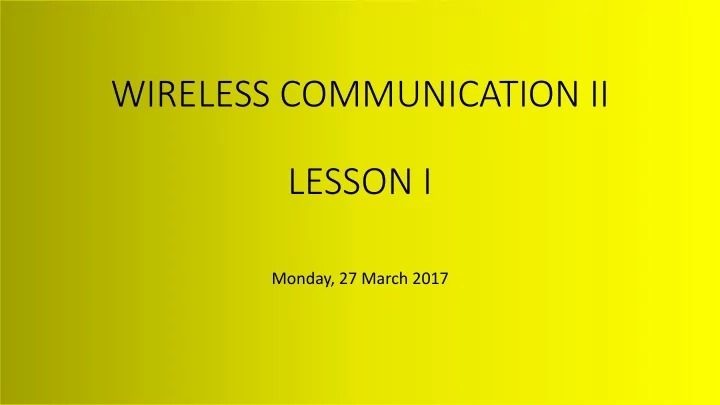

WIRELESS COMMUNICATION II LESSON I Monday, 27 March 2017
ETI 2511-CURRICULUM(1) ETI 2511 Wireless Communications II (45 Lecture Hours) Prerequisites ETI2505 Wireless Communications I ETI 2506 Telecommunication Systems Purpose The aim of this course is to enable the student to: 1. understand the differences between cellular telephone generations 2. explain the reasons behind the rapid growth in mobile communications 3. know the ITU standards relevant to mobile communications 4. design cellular mobile telephone systems Learning Outcomes At the end of this course, the student should be able to: 1. Describe the characteristics of cellular telephone generations. 2. Describe the advantages and limitations of mobile communication systems. 3. Describe the channelization methods used in cellular mobile communications. 4. Perform traffic and link budget calculations for cellular telephone systems.
ETI 2511-CURRICULUM (2) Course Description 1. Overview of wireless technologies and cellular mobile communication systems; 2. Characteristics of 1st, 2nd and 3rd generation mobile communication systems. 3. UMTS/3G system, 4. ITU Wireless Standards. 5. Differences between CDMA-type and GSM networks. 6. Spectral efficiency in Wireless Communication Systems 7. Type of channels: traffic, paging, control channels. 8. Channelization methods in CDMA and GSM. 9. Air interface communication protocols.
ETI 2511-CURRICULUM (3) 10. Fundamentals of Cellular communications: geometry of a hexagonal cell, co- channel interference ratio. 11. Cellular system design for different sector and antenna patterns; 12. Omni-directional, three sector and six sector directional antennas. 13. Traffic and signalling planning, modelling, system dimensioning (capacity determination) and cell splitting.
ETI 2511-CURRICULUM (4) 14. RF propagation considerations in cellular mobile environment. Diversity reception, LOS, Fresnel zones. 15. Link budget calculations using theoretical and empirical formulae: Okumura and Hata models etc. 16. Hand-off methods: hard hand-off, soft hand-off. 17. General architecture and interfaces of cellular system and the PSTN and Internet networks: BTS, MSC, Internetworking, user registers etc.
ETI 2511-CURRICULUM (5) 17. Roaming, performance management, protocols. 18. Functional description of subsystems. 19. Long Term Evolution (LTE) technology
RECOMMENDED BOOKS Course Textbooks 1. Vijay Garg, Wireless Communications and Networking , Elsevier, 2007. 2. Garg V.K. & Wilkes J. E. (2007), Principles and Applications of GSM , Pearson Education 3. Karim M.R. & Sarraf M. (2002), W-CDMA and cdma 2000, McGraw Hill Reference Textbooks 1. Garg V.K. & Wilkes J.E, (1996), Wireless and Personal Communications Systems , Prentice Hall PTR 2. Schiller J. (2007), Mobile Communications , 2nd Ed, Pearson Education
Recommend
More recommend